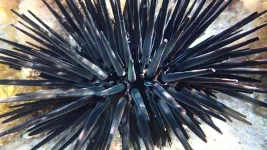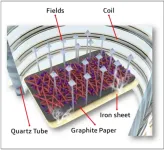(Press-News.org)
· Diseased neurons have pathology in which proteins become misfolded and toxic
· Normally supportive cells attack the diseased neurons and destroy them
· This pathology occurs in 90% of ALS patient brains and in frontotemporal dementia and Alzheimer’s disease
CHICAGO --- Northwestern Medicine scientists have discovered two ways to preserve diseased upper motor neurons that would normally be destroyed in ALS, based on a study in mice. Upper motor neurons initiate movement, and they degenerate in ALS.
These neurons have a pathology — called TDP-43 pathology — in which aggregating proteins inside the cell become misfolded and toxic to the neuron. This happens in about 90% of all ALS patient brains and is one of the most common problems in neurodegeneration, detected also in the brains of frontotemporal dementia and Alzheimer’s disease patients.
When there is TDP-43 pathology, this activates astrocytes and microglia – two types of cells that once were supportive, but now become deleterious, to attack and destroy the diseased neurons in the brain.
“When astrocytes and microglia eat diseased motor neurons, they are gone for good, and the window of opportunity to improve their health is lost,” said lead investigator Hande Ozdinler, associate professor of neurology at Northwestern University Feinberg School of Medicine. “There is no turning back from neurodegeneration when the neurons are destroyed by astrocytes and microglia.
“That is a major problem in ALS and in other neurodegenerative diseases, and one of the reasons the disease progresses fast. Normally, that fast progression correlates with the activation of the astrocytes and microglia. We need to find ways to keep them calm.”
In two new studies, Ozdinler and colleagues identify two independent ways to reduce the destruction of the upper motor neurons that are diseased with TDP-43 pathology in ALS by calming the angry astrocytes and microglia. They found that a gene therapy approach and a small molecule treatment are both are effective in mouse models of TDP-43 pathology. The genetic delivery of hepatocyte growth factor (HGF) soothes the astrocytes in the brain.
The findings will be published Feb. 23 in Nature Gene Therapy.
The Northwestern scientists also found that when the integrity of the mitochondria (the energy producer for the cell) is improved inside the diseased neurons, the astrocytes stop attacking them. Scientists fed the TDP-43 mouse models of ALS with the compound SBT-272, which binds and repairs the inner mitochondrial membrane. This prevents it from breaking down or becoming leaky, a phenomenon that is broadly observed in diseased neurons in ALS and other neurodegenerative diseases.
“We started giving the SBT-272 to mice, when they began to show symptoms of ALS, meaning when the mitochondria were already defective,” Ozdinler said. “The compound helped repair the mitochondrial damage, reducing the impact of TDP-43 pathology. Most importantly, astrocytes and microglia stopped attacking. This is then reflected on neuronal heath.”
This finding about how improving mitochondrial health was just published in Neurobiology of Disease.
The next steps in the research are to develop combination treatments to overcome complex diseases like ALS. “We believe a combination of treatments would work much better and would bring us much closer to a cure, as we need to do two things at the same time: (1) improve the health of diseased upper motor neurons; and (2) decrease the deleterious effects of the astrocytes and microglia that kill them,” Ozdinler said.
Other Northwestern authors on the studies are Mukesh Gautam, Barıs Genç, Benjamin Helmold, Angela Ahrens, Öge Gözütok and Suchitra Swaminathan.
The research was funded in part by grant R21-NS085750 from National Institute of Neurological Disorders and Stroke of the National Institutes of Health, NUCATS Translational Innovation Grant, Spastic Paraplegia Foundation, Stealth BioTherapeutics and Helixmith, Co., Ltd.
END
Curtin University researchers believe rising sea temperatures are to blame for the plummeting number of invertebrates such as molluscs and sea urchins at Rottnest Island off Western Australia, with some species having declined by up to 90 per cent between 2007 and 2021.
Lead author Adjunct Professor Fred Wells, from Curtin’s School of Molecular and Life Sciences, said the west end of Rottnest Island had suffered a “catastrophic decline” in biodiversity.
“Since 1982, we have monitored biodiversity of marine molluscs and echinoderms ...
This study is led by Dr. Shaowei Chen (University of California). Natural gas reforming accounts for 95% of the hydrogen gas produced in the United States; yet the hydrogen is non-sustainable and “grey”, as it originates from fossil fuels . To obtain sustainable “green” hydrogen gas, electrochemical water splitting by using renewable electricity has emerged as one of the most promising technologies, which consists of hydrogen evolution reaction (HER) at the cathode and oxygen evolution reaction (OER) at the anode . Yet, due to the sluggish electron-transfer kinetics and complex reaction pathways, OER typically entails a large overpotential and severely ...
By Jovina Ang
SMU Office of Research & Tech Transfer – There are many reasons why knowledge management is important for an organisation.
Among the many reasons, the most mentioned are:
Speed up access to information and knowledge, or to people who hold the information you need;
Improve decision-making processes;
Promote innovation due to the sharing of ideas, collaboration and access to the latest information;
Improve the efficiency and productivity via reducing the tendency to “reinvent the wheel”;
Increase customer ...
After competing in the finals with the University College London, which presented Bubble Worlds, the research team led by Dr. Sona Kwak from the Korea Institute of Science and Technology (KIST; President Seok Jin Yoon) presented "CollaBot" and received the best award in the "hardware, design, and interface" category at the Robot Design Competition hosted by the International Conference on Social Robotics (ICSR) 2022, which was held at the Chamber of Commerce in Florence, Italy (December 13-16, 2022).
Previous studies on social robots were primarily based on humanoid robots that understand the context of situations and provide a range ...
By Alvin Lee
SMU Office of Research & Tech Transfer – When Chinese consumer electronics giant Xiaomi (小米) listed on the Hong Kong Stock Exchange (SEHK) in June 2018, it followed the well-beaten path travelled by earlier mainland companies, ranging from high-tech predecessors Tencent (腾讯, 0700.HK) to non-tech companies such as Tsingtao Brewery (0168.HK) and China Eastern Airlines (0670.HK).
While the IPO raised US$4.72 billion in the tech world’s biggest float in four years, it garnered extra attention for being the first SEHK listing with dual-class shares ...
By Alistair Jones
SMU Office of Research & Tech Transfer – The life of a researcher is not for everyone, but for Yuliya Dzyuban, a Research Fellow in the new College of Integrative Studies at Singapore Management University (SMU), it's a perfect fit.
“With time, I realised that studying is what I do best and enjoy the most. Research offers opportunities for endless learning,” she says.
“There are always new projects, new challenges, new ideas and evolving methods. I love the fact that I can learn something ...
By Alistair Jones
SMU Office of Research & Tech Transfer – Despite hero moments in movies where fingers clatter at dizzying speed across computer keyboards, not everyone in the real world finds code fascinating, nor algorithms intriguing.
In fact, there is a worldwide shortage of skilled data scientists and software engineers.
David Lo, a Professor of Computer Science at Singapore Management University (SMU), suggests two reasons for the shortfall.
“First, software today is everywhere; organisations, companies, governments ...
An analysis of fossils of non-avialan theropod dinosaurs – a dinosaur clade that includes an array of body sizes – has provided findings that run contrary to expectations regarding the factors that inform the evolution of body size diversity. “Once quantified and analyzed in a phylogenetic framework [like this], we predict that diverse growth strategies will be recognized in other clades,” say the study’s authors. Over evolutionary history, many taxa have evolved very large and very small body sizes, and even closely related species can exhibit widely disparate sizes. ...
In the UK, disparities in mortality risk factors exist between ethnic groups, with differences in overall mortality, top causes of mortality and individual mortality risk factors, according to a new study published this week in the open-access journal PLOS Global Public Health by I. King Jordan of Georgia Institute of Technology, US, and colleagues.
Despite the progress made in improving mortality rate, life expectancy, and disease survival outcomes in the last century, health disparities between various population ...
RICHLAND, Wash.—There’s a lot of potentially useful raw materials bound up in used face masks, grocery bags and food wrap. But it has been much cheaper to keep making more of these single-use plastics than to recover and recycle them.
Now, an international research team led by the Department of Energy’s Pacific Northwest National Laboratory has cracked the code that stymied previous attempts to break down these persistent plastics. They reported their discovery in today’s issue of Science.
Low temperature and reaction control
Typically, recycling plastics requires ‘cracking’ or ...








